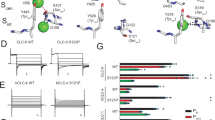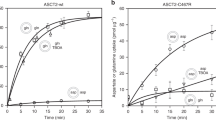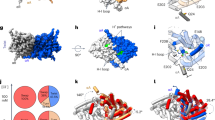Abstract
Ion binding to secondary active transporters triggers a cascade of conformational rearrangements resulting in substrate translocation across cellular membranes. Despite the fundamental role of this step, direct measurements of binding to transporters are rare. We investigated ion binding and selectivity in CLC-ec1, a H+-Cl− exchanger of the CLC family of channels and transporters. Cl− affinity depends on the conformation of the protein: it is highest with the extracellular gate removed and weakens as the transporter adopts the occluded configuration and with the intracellular gate removed. The central ion-binding site determines selectivity in CLC transporters and channels. A serine-to-proline substitution at this site confers NO3− selectivity upon the Cl−-specific CLC-ec1 transporter and CLC-0 channel. We propose that CLC-ec1 operates through an affinity-switch mechanism and that the bases of substrate specificity are conserved in the CLC channels and transporters.
This is a preview of subscription content, access via your institution
Access options
Subscribe to this journal
Receive 12 print issues and online access
$189.00 per year
only $15.75 per issue
Buy this article
- Purchase on Springer Link
- Instant access to full article PDF
Prices may be subject to local taxes which are calculated during checkout








Similar content being viewed by others
References
Price, W.S. & Kuchel, P.W.C.B.A. A 35Cl and 37Cl NMR study of chloride binding to the erythrocyte anion transport protein. Biophys. Chem. 40, 329–337 (1991).
Fang, Y., Kolmakova-Partensky, L. & Miller, C. A bacterial arginine-agmatine exchange transporter involved in extreme acid resistance. J. Biol. Chem. 282, 176–182 (2007).
Lockless, S.W., Zhou, M. & MacKinnon, R. Structural and thermodynamic properties of selective ion binding in a K+ channel. PLoS Biol. 5, e121 (2007).
Boudker, O., Ryan, R., Yernool, D., Shimamoto, K. & Gouaux, E. Coupling substrate and ion binding to extracellular gate of a sodium-dependent aspartate transporter. Nature 445, 387–933 (2007).
Nie, Y., Smirnova, I., Kasho, V. & Kaback, H.R. Energetics of ligand-induced conformational flexibility in the lactose permease of Escherichia coli. J. Biol. Chem. 281, 35779–35984 (2006).
Singh, S., Yamashita, A. & Gouaux, E. Antidepressant binding site in a bacterial homologue of neurotransmitter transporters. Nature 448, 952–956 (2007).
Singh, S., Piscitelli, C., Yamashita, A. & Gouaux, E. A competitive inhibitor traps LeuT in an open-to-out conformation. Science 322, 1655–1661 (2008).
Hille, B. Ion Channels of Excitable Membranes (Sinauer, Sunderland, Massachusetts, USA, 2001).
DiFrancesco, D. & Tortora, P. Direct activation of cardiac pacemaker channels by intracellular cyclic AMP. Nature 351, 145–147 (1991).
Magleby, K. Gating mechanism of BK (Slo1) channels: so near, yet so far. J. Gen. Physiol. 121, 81–96 (2003).
Nimigean, C., Shane, T. & Miller, C. A cyclic nucleotide modulated prokaryotic K+ channel. J. Gen. Physiol. 124, 203–210 (2004).
Dutzler, R., Campbell, E.B., Cadene, M., Chait, B.T. & MacKinnon, R. X-ray structure of a ClC chloride channel at 3.0 Å reveals the molecular basis of anion selectivity. Nature 415, 287–294 (2002).
Accardi, A. & Miller, C. Secondary active transport mediated by a prokaryotic homologue of ClC Cl− channels. Nature 427, 803–807 (2004).
Picollo, A. & Pusch, M. Chloride/proton antiporter activity of mammalian CLC proteins ClC-4 and ClC-5. Nature 436, 420–423 (2005).
Scheel, O., Zdebik, A.A., Lourdel, S. & Jentsch, T.J. Voltage-dependent electrogenic chloride/proton exchange by endosomal CLC proteins. Nature 436, 424–427 (2005).
Miller, C. ClC chloride channels viewed through a transporter lens. Nature 440, 484–489 (2006).
De Angeli, A. et al. The nitrate/proton antiporter AtCLCa mediates nitrate accumulation in plant vacuoles. Nature 442, 939–942 (2006).
Graves, A., Curran, P., Smith, C. & Mindell, J. The Cl−/H+ antiporter ClC-7 is the primary chloride permeation pathway in lysosomes. Nature 453, 788–792 (2008).
Jentsch, T.J. CLC chloride channels and transporters: from genes to protein structure, pathology and physiology. Crit. Rev. Biochem. Mol. Biol. 43, 3–36 (2008).
Dutzler, R., Campbell, E.B. & MacKinnon, R. Gating the selectivity filter in ClC chloride channels. Science 300, 108–112 (2003).
Lobet, S. & Dutzler, R. Ion-binding properties of the ClC chloride selectivity filter. EMBO J. 25, 24–33 (2005).
Accardi, A., Lobet, S., Williams, C., Miller, C. & Dutzler, R. Synergism between halide binding and proton transport in a CLC-type exchanger. J. Mol. Biol. 362, 691–699 (2006).
Accardi, A. et al. Separate ion pathways in a Cl−/H+ exchanger. J. Gen. Physiol. 126, 563–570 (2005).
Nguitragool, W. & Miller, C. Uncoupling of a CLC Cl−/H+ exchange transporter by polyatomic anions. J. Mol. Biol. 362, 682–690 (2006).
Nguitragool, W. & Miller, C. CLC Cl−/H+ transporters constrained by covalent cross-linking. Proc. Natl. Acad. Sci. USA 104, 20659–20665 (2007).
Walden, M. et al. Uncoupling and turnover in a Cl−/H+ exchange transporter. J. Gen. Physiol. 129, 317–329 (2007).
Jayaram, H., Accardi, A., Wu, F., Williams, C. & Miller, C. Ion permeation through a Cl−-selective channel designed from a CLC Cl−/H+ exchanger. Proc. Natl. Acad. Sci. USA 105, 11194–11199 (2008).
Ladbury, J.E. & Doyle, M.L. Biocalorimetry 2: Applications of Calorimetry in the Biological Sciences (Wiley, Hoboken, New Jersey, USA, 2004).
Wiseman, T., Williston, S., Brandts, J.F. & Lin, L.N. Rapid measurement of binding constants and heats of binding using a new titration calorimeter. Anal. Biochem. 179, 131–137 (1989).
Turnbull, W.B. & Daranas, A.H. On the value of c: can low affinity systems be studied by isothermal titration calorimetry? J. Am. Chem. Soc. 125, 14859–14866 (2003).
Tellinghuisen, J. Isothermal titration calorimetry at very low c. Anal. Biochem. 373, 395–397 (2008).
Iyer, R., Iverson, T.M., Accardi, A. & Miller, C. A biological role for prokaryotic ClC chloride channels. Nature 419, 715–718 (2002).
Accardi, A., Kolmakova-Partensky, L., Williams, C. & Miller, C. Ionic currents mediated by a prokaryotic homologue of CLC Cl− channels. J. Gen. Physiol. 123, 109–119 (2004).
Lim, H.H. & Miller, C. Intracellular proton-transfer mutants in a CLC Cl−/H+ exchanger. J. Gen. Physiol. 133, 131–138 (2009).
Faraldo-Gomez, J.D. & Roux, B. Electrostatics of ion stabilization in a ClC chloride channel homologue from Escherichia coli. J. Mol. Biol. 339, 981–1000 (2004).
Nimigean, C. & Pagel, M. Ligand binding and activation in a prokaryotic cyclic nucleotide-modulated channel. J. Mol. Biol. 371, 1325–1337 (2007).
Zifarelli, G. & Pusch, M. Conversion of the 2 Cl−/1 H+ antiporter ClC-5 in a NO3−/H+ antiporter by a single point mutation. EMBO J. advance online publication, doi:10.1038/emboj.2008.284 (8 January 2009).
Ludewig, U., Pusch, M. & Jentsch, T.J. Two physically distinct pores in the dimeric ClC-0 chloride channel. Nature 383, 340–343 (1996).
Pusch, M., Ludewig, U., Rehfeldt, A. & Jentsch, T.J. Gating of the voltage-dependent chloride channel CIC-0 by the permeant anion. Nature 373, 527–531 (1995).
Chen, T.Y. & Miller, C. Nonequilibrium gating and voltage dependence of the ClC-0 Cl− channel. J. Gen. Physiol. 108, 237–250 (1996).
Traverso, S., Elia, L. & Pusch, M. Gating competence of constitutively open CLC-0 mutants revealed by the interaction with a small organic Inhibitor. J. Gen. Physiol. 122, 295–306 (2003).
Miller, C. & Nguitragool, W. A provisional transport mechanism for a chloride channel-type Cl−/H+ exchanger. Phil. Trans. R. Soc. Lond. B 364, 175–180 (2009).
Ogawa, H. & Toyoshima, C. Homology modeling of the cation binding sites of Na+K+-ATPase. Proc. Natl. Acad. Sci. USA 99, 15977–15982 (2002).
Ma, H., Inesi, G. & Toyoshima, C. Substrate-induced conformational fit and headpiece closure in the Ca2+ ATPase (SERCA). J. Biol. Chem. 278, 28938–29043 (2003).
Inesi, G.M.H., Hua, S. & Toyoshima, C. Characterization of Ca2+ ATPase residues involved in substrate and cation binding. Ann. NY Acad. Sci. 986, 63–71 (2003).
Toyoshima, C., Nomura, H. & Sugita, Y. Crystal structures of Ca2+-ATPase in various physiological states. Ann. NY Acad. Sci. 986, 1–8 (2003).
Matulef, K. & Maduke, M. Side-dependent inhibition of a prokaryotic ClC by DIDS. Biophys. J. 89, 1721–1730 (2005).
Zdebik, A.A. et al. Determinants of anion-proton coupling in mammalian endosomal CLC proteins. J. Biol. Chem. 283, 4219–4227 (2008).
Richard, H. & Foster, J. Escherichia coli glutamate- and arginine-dependent acid resistance systems increase internal pH and reverse transmembrane potential. J. Bacteriol. 186, 6032–6041 (2004).
Gut, H. et al. Escherichia coli acid resistance: pH-sensing, activation by chloride and autoinhibition in GadB. EMBO J. 25, 2643–2651 (2006).
Ludewig, U., Jentsch, T.J. & Pusch, M. Analysis of a protein region involved in permeation and gating of the voltage-gated Torpedo chloride channel ClC-0. J. Physiol. (Lond.) 498, 691–702 (1997).
Rychkov, G., Pusch, M., Roberts, M. & Bretag, A. Interaction of hydrophobic anions with the rat skeletal muscle chloride channel ClC-1: effects on permeation and gating. J. Physiol. (Lond.) 530, 379–393 (2001).
Pusch, M., Jordt, S.E., Stein, V. & Jentsch, T.J. Chloride dependence of hyperpolarization-activated chloride channel gates. J. Physiol. (Lond.) 515, 341–353 (1999).
Bergsdorf, E.Y., Zdebik, A.A. & Jentsch, T.J. Residues important for nitrate/proton coupling in plant and mammalian CLC transporters. J. Biol. Chem. 284, 11184–11193 (2009).
Acknowledgements
The authors wish to thank C. Miller (Brandeis University) for unrelenting constructive criticism and for the generous gifts of the CLC-ec1 and CLC-0 clones, K. Campbell, S. England, S. Khademi, R. Subramanian and D. Segaloff for comments on the manuscript, J. Lueck for helpful discussions and comments on the manuscript, C. Blaumueller for expert editing and C. Hills for technical assistance. This work was supported by grant 1R01GM085232 from the US National Institutes of Health to A.A.
Author information
Authors and Affiliations
Contributions
A.A. designed research; A.P., M.M. and A.A. performed experiments; A.P., M.M., J.H. and A.A. analyzed the data; A.P. and A.A. wrote the paper.
Corresponding author
Supplementary information
Supplementary Text and Figures
Supplementary Table 1, Supplementary Figures 1–7 and Supplementary Methods (or Discussion or Data) (PDF 4016 kb)
Rights and permissions
About this article
Cite this article
Picollo, A., Malvezzi, M., Houtman, J. et al. Basis of substrate binding and conservation of selectivity in the CLC family of channels and transporters. Nat Struct Mol Biol 16, 1294–1301 (2009). https://doi.org/10.1038/nsmb.1704
Received:
Accepted:
Published:
Issue Date:
DOI: https://doi.org/10.1038/nsmb.1704
This article is cited by
-
A CLC-type F-/H+ antiporter in ion-swapped conformations
Nature Structural & Molecular Biology (2018)
-
Structure of a CLC chloride ion channel by cryo-electron microscopy
Nature (2017)
-
The Ec-NhaA antiporter switches from antagonistic to synergistic antiport upon a single point mutation
Scientific Reports (2016)
-
Ion transport mechanism in ClC-type channel protein under complex electrostatic potential
Wuhan University Journal of Natural Sciences (2016)
-
Conformational changes required for H+/Cl− exchange mediated by a CLC transporter
Nature Structural & Molecular Biology (2014)



